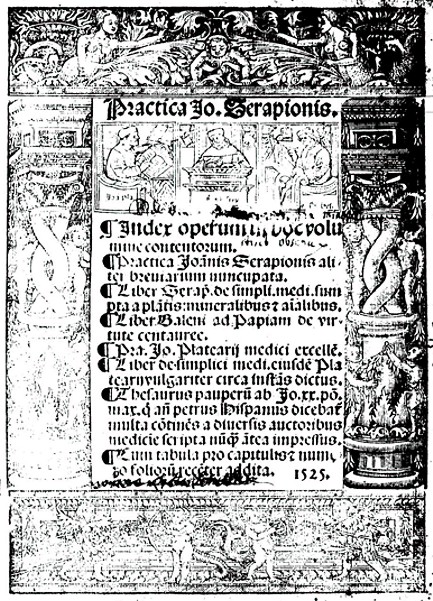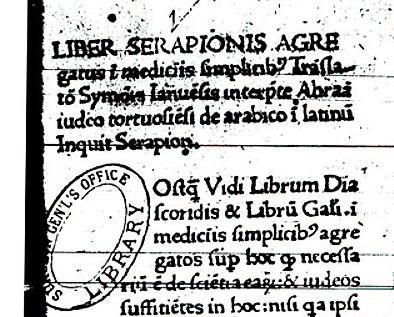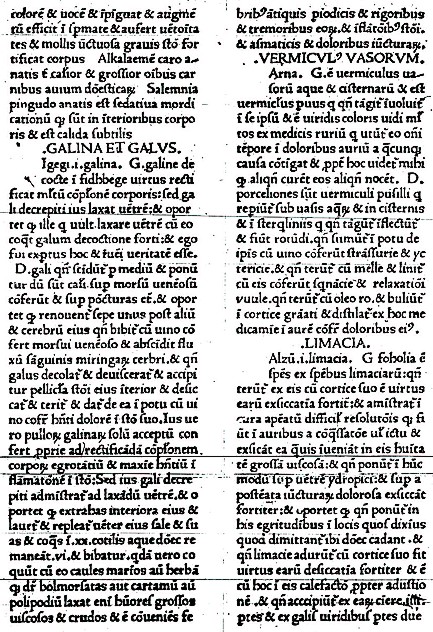Lessico
Serapione
il Vecchio
Serapione il Giovane
Yuhanna Ibn Sarabiyun
Serapione
citato da Aldrovandi nel II volume di Ornitologia (1600) dovrebbe essere il
medico siriano vissuto nel IX-X secolo il cui nome era Yuhanna Ibn Sarabiyun detto anche Serapione il Vecchio e i cui scritti
furono tradotti da Gherardo da Cremona![]() con il titolo di Breviarium
medicinae.
con il titolo di Breviarium
medicinae.

Practica Joannis Serapionis aliter brevarium nuncupata - 1525
Nell’XI-XII secolo visse invece Serapione il Giovane - anch’egli
Yuhanna Ibn Sarabiyun - i cui scritti furono tradotti da Simone da Genova![]() (morto nel 1303) con il titolo di De simplici medicina o Liber
Serapionis.
(morto nel 1303) con il titolo di De simplici medicina o Liber
Serapionis.


De simplici medicina
o Liber
Serapionis di Serapione il Giovane – 1473
tradotto da Simone da Genova
La gallina e il gallo in latino qui suonano Galina et Galus.
Dictionnaire
historique
de la médecine ancienne et moderne
par Nicolas François Joseph Eloy
Mons – 1778
Serapione di Alessandria
Uscendo un attimo dal seminato, ma per completezza onomastica e professionale, citiamo anche Serapione di Alessandria, medico greco vissuto nella prima metà del sec. II aC. Ricordato, con Filino di Coo, tra gli iniziatori della scuola empirica; sostenne la necessità del ricorso all'osservazione diretta del malato e dei suoi sintomi negando qualsiasi validità alle teorie scientifiche. Ha lasciato vari scritti su argomenti di diagnosi e terapia.
Dictionnaire historique
de la médecine ancienne et moderne
par Nicolas François Joseph Eloy
Mons – 1778
The physician of Pope Honorius IV was Taddeo Alderotti (Firenze 1215 or 1223 - Bologna 1295) who was famous as a teacher of medicine and a writer on medical topics about this time. Alderotti's work represents what is best in medicine during this century. Alderotti's successor as physician at the papal court was scarcely, if any, less distinguished. This was Simon Januensis, Simon of Genoa (d. 1303), medical attendant to Pope Nicholas IV (1288-1292). Simon did much to make the use of opium more scientific than it had been and worked out rules for its administration. Simon is best known in the history of medicine for what was probably the first important dictionary of medicine. This was his Synonyma medicinae or Clavis sanationis, "The Key of Health." Steinschneider declares this to be one of the most important works in the field of synonymics. (The Catholic Church and Healing by James J Walsh, 1928 - Part 3 chapter VIII The Papal Physicians - www.churchinhistory.org)
Before 1542 the works principally used by apothecaries were the treatises on simples by Avicenna and Serapion; the De synonymis and Quid pro quo of Simon Januensis; the Liber servitoris of Bulchasim Ben Aberazerim, which described the preparations made from plants, animals and minerals, and was the type of the chemical portion of modern pharmacopoeias; and the Antidotarium of Nicolaus de Salerno, containing Galenical compounds arranged alphabetically. Of this, last work there were two editions in use — Nicolaus magnus and Nicolaus parvus: in the later several of the compounds described in the large edition were omitted and the formulae given on a smaller scale. (web)
Simonis Januensis opusculum, cui nomen clavis sanationis simplicia medicinalia latina greca ^[et] arabica ordine alphabetico mirifice elucidans recognitum ac mendis purgatum etc. - Venetiis, 1514.